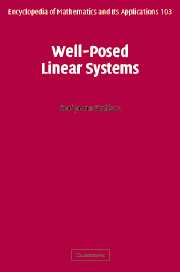Book contents
- Frontmatter
- Contents
- List of figures
- Preface
- List of notation
- 1 Introduction and overview
- 2 Basic properties of well-posed linear systems
- 3 Strongly continuous semigroups
- 4 The generators of a well-posed linear system
- 5 Compatible and regular systems
- 6 Anti-causal, dual, and inverted systems
- 7 Feedback
- 8 Stabilization and detection
- 9 Realizations
- 10 Admissibility
- 11 Passive and conservative scattering systems
- 12 Discrete time systems
- Appendix
- Bibliography
- Index
12 - Discrete time systems
Published online by Cambridge University Press: 13 October 2009
- Frontmatter
- Contents
- List of figures
- Preface
- List of notation
- 1 Introduction and overview
- 2 Basic properties of well-posed linear systems
- 3 Strongly continuous semigroups
- 4 The generators of a well-posed linear system
- 5 Compatible and regular systems
- 6 Anti-causal, dual, and inverted systems
- 7 Feedback
- 8 Stabilization and detection
- 9 Realizations
- 10 Admissibility
- 11 Passive and conservative scattering systems
- 12 Discrete time systems
- Appendix
- Bibliography
- Index
Summary
In this chapter we give a short overview of discrete time systems. Especially in the L2-well-posed case on a triple of Hilbert spaces there is a fairly close connection between the discrete-time and continuous-time theory. The crucial transformation between these two settings is the Cayley transform (which we have already encountered implicitly in Chapter 11) and its time-domain version, the Laguerre transform. In the last section we return to continuous time, using the discrete time theory to develop the continuous time reciprocal transformation.
Discrete time systems
Throughout this book we have been working with systems whose time variable is continuous (as opposed to discrete). Below we shall develop an analogous theory for systems in discrete time. We have already encountered such systems in passing in Section 2.4, where we discretized the time to be able to carry out some of the proofs in discrete time. In the next section we shall see another method to pass between continuous and discrete time.
As in the case of a continuous time system, it is possible to define a discrete time system by specifying either its ‘generating operators,’ or the input/state/output maps. In the continuous time case the latter approach is simpler because of the unboundedness of the generating operators, but in discrete time the situation is the opposite: it is common to start with the generating operators (which are bounded in this case), and to use these to define the input/state/output maps.
- Type
- Chapter
- Information
- Well-Posed Linear Systems , pp. 696 - 729Publisher: Cambridge University PressPrint publication year: 2005



